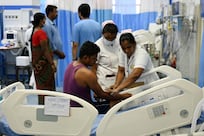Move over, global warming. The cosmos has another major threat for Planet Earth: solar super-storms.
The last one hit Earth in 2003, crippling South Africa's power supply.
Two solar tempests in 1989 plunged the Canadian province of Quebec into mid-winter darkness and sparked a deadly explosion on Russia's trans-Siberian gas pipeline.
Back in 1859, energy from the most severe solar storm on record surged through the new-fangled US telegraph system, rendering it unusable for a time.
Now scientists say an unusually quiet period for solar eruptions has ended and a new storm cycle will peak within two years. They are worried about a large mass of magnetised solar plasma being ripped from the sun's surface and flung towards Earth.
"The sun is waking up from a deep slumber, and in the next few years we expect to see much higher levels of solar activity," says Dr Richard Fisher, the head of heliophysics at the US National Aeronautics and Space Administration. "At the same time, our technological society has developed an unprecedented sensitivity to solar storms."
The storm warning has been on the radar of the US National Academy of Sciences for several years. In 2008, the academy estimated that a century-class solar storm today could wreak 20 times more economic damage than Hurricane Katrina, with recovery costs in the first year running as high as US$2 trillion (Dh7.34tn).
Researchers expect a major solar event to trigger widespread power cuts that could cause "disruption of the transportation, communication, banking and finance systems, and government services; the breakdown of the distribution of potable water owing to pump failure; and the loss of perishable foods and medications because of lack of refrigeration".
That is even without reckoning with the direct effects of solar flares on communications and navigation satellites.
The vulnerability of modern electrical grids to stormy "space weather" is due to increasing use of long sections of high-voltage cable, especially the high-voltage direct-current (HVDC) cables that carry power over vast distances.
Such spans act as long-distance highways for earthbound energy originating from the solar wind. But the exit ramps where power is diverted for local use are regulated by high-voltage electrical transformers which handle power surges poorly. They get fried by surges.
That happened to 14 big transformers in South Africa on Halloween in 2003.
The mess of fused copper "contributed significantly to that country's long-running struggle to adequately provide the population and industry with electricity", Samuel Fenwick, the editor of Industrial Fuels and Power, wrote last year.
Modern "smart grids" include fibre-optic cables, which add the power of the internet to electricity transmission networks. Unlike copper wires, these do not serve as conduits for "geomagnetically induced currents". But they can certainly transmit garbled data when a solar flare hits Earth. In the worst case, unpredictable responses to the erroneous signals can cause grid failure.
Other information networks with complex electronic control systems are equally vulnerable. Solar storms have caused railway signals to malfunction, sometimes with tragic results.
Zurich Services, a Swiss risk management consultancy that last year prepared a background paper on the hazards of solar storms, says the modern power grid's complexity is both its greatest strength and weakness.
"The modern electrical grid is interconnected for efficient transmission of large quantities of power over a large distributed network," it says. "However, that same interconnectedness … also makes it extremely vulnerable to cascading catastrophic failures."
A number of measures are possible, although few are required under the patchwork of regulations that govern the "supergrids" of North America and Europe. Power grids in other regions tend to be even more loosely regulated.
Zurich Services suggests protecting critical signalling devices with radiation shielding, equipping transformers with surge protectors, burying HVDC cables, increasing the robustness of control-system architecture and improving solar weather forecasts. If flares could be reliably predicted, vulnerable grid sections could be isolated and power stations temporarily shut down.
AV Riswadkar and Buddy Dobbins, two of the company's "risk engineers", concede the coming solar cycle could be a "non-event" as Y2K was. And yet, "the threat of solar storms and associated space weather risks are rare but real and should not be ignored".
"Such an event does not have any precedence for comparison for the potential severity of impact. It can be considered an unrecognised catastrophic risk due to our increased reliance on technology today."
Sir John Beddington, the UK chief scientist, agrees.
"There are two things we need to be thinking about," he said in Washington last month. "We need to think about prediction - the ability to categorise and give warning about when particular types of space weather are likely to occur. The second is about engineering - thinking about particular sectors and their vulnerability to particular types of space weather. That is a complicated issue and we need to think hard about how to do that."
Researchers are already on the case.





